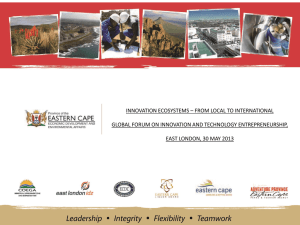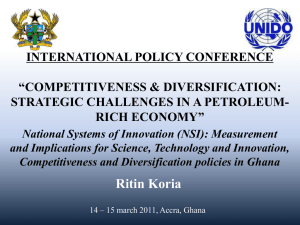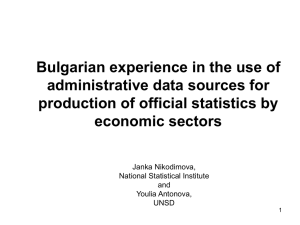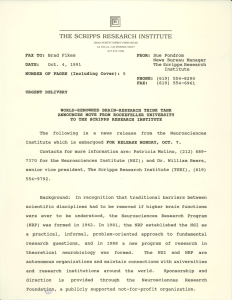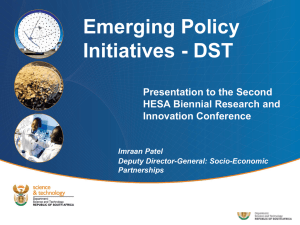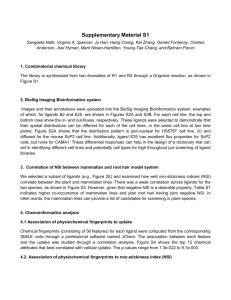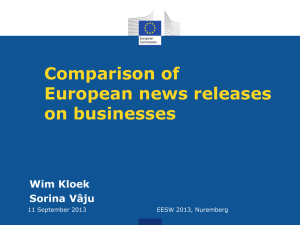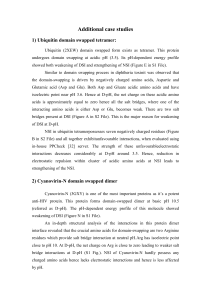Fuels and energy consumption 2011
advertisement
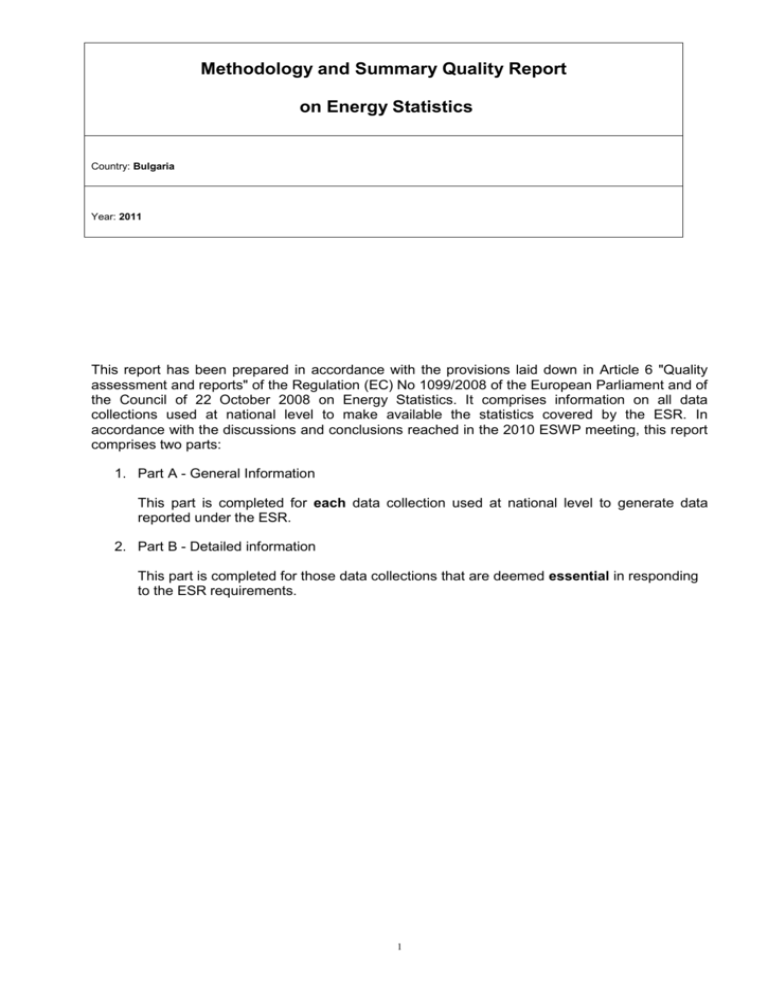
Methodology and Summary Quality Report on Energy Statistics Country: Bulgaria Year: 2011 This report has been prepared in accordance with the provisions laid down in Article 6 "Quality assessment and reports" of the Regulation (EC) No 1099/2008 of the European Parliament and of the Council of 22 October 2008 on Energy Statistics. It comprises information on all data collections used at national level to make available the statistics covered by the ESR. In accordance with the discussions and conclusions reached in the 2010 ESWP meeting, this report comprises two parts: 1. Part A - General Information This part is completed for each data collection used at national level to generate data reported under the ESR. 2. Part B - Detailed information This part is completed for those data collections that are deemed essential in responding to the ESR requirements. 1 Methodology and Summary Quality Report on Energy Statistics Part A - General Information Country: Bulgaria Year: 2011 In case the fields provided in this form offer insufficient space, then please refer to numbered attachments. 1. Name of the data collection Indicate the name of the data collection. Fuels and energy consumption 2. National body responsible Indicate the name and address of the national body responsible for the data collection. National Statistical Institute, 2, P. Volov Str.; Sofia, Bulgaria 3. Objective and history Outline the overall objective, indicating the broad field covered by this data collection. Also describe the way this data collection interacts with or complements other national data collections in order to respond to the ESR requirements. Summarise the evolution of this data collection over time (starting with the year of implementation) and give details of availability of time series data, including break in series. NSI implements data collection only. Data for total consumption by type of main energy products have collected for more than thirty years. Since 1997, for more accurate data on final energy consumption, data collection is implemented together with other data collections – “Balance of energy-transformation processes”: - “Electricity and heat generation” - “Lignite briquettes production” - “Coke oven coke production” - “Blast furnace gas production” - “Petroleum products production” After the year 2000, the data by aggregate economic activities on scheme of overall energy balance are available in website of NSI, under theme “Energy”, subtheme “6.1.Overall energy balance sheet” - http://www.nsi.bg/otrasalen.php?otr=37 4. Reference period, frequency and transmission deadline Indicate the reference period, frequency and deadline for data transmission. Data are collected annually, for calendar year, up to end of March, following reference year by printed form in Regional Statistical Offices (RSO) or by electronic form online in “Information System Business Statistics” (ISBS) on NSI’s server. By the end of June, data from printed form are entered into ISBS from experts in RSO. 2 Methodology and Summary Quality Report on Energy Statistics Part B - Detailed information In case the fields provided in this form offer insufficient space, then please refer to numbered attachments. 5. Legal framework Indicate the legal force (voluntary or mandatory). In the case of mandatory data collection, indicate any relevant national law (beyond the Energy Statistics Regulation). Data are collected mandatory, based on Annual National Statistical Program, which is elaborated in accordance with Chapter Three of the Bulgarian Statistics Law http://www.nsi.bg/pageen.php?P=174&SP=175&SSPP=345 . 6. Statistical concepts and method 6.1 Variables surveyed and derived Give a comprehensive list of the variables (flows) and all energy commodities covered by this data collection. Use the nomenclature of the Energy Statistics Regulation to allow identification of the field (questionnaire and table) covered by the data collection. Indicate the measure units used for reporting each energy commodity and any associated conversion factors used at national level. 1. The surveyed variables are: - opening stock levels - closing stock levels; - total consumption and of which: for non-energy use; for transport; for agriculture/construction engines and other stationary engines These variables are collected in specific measure unit for each energy product. 2. With this survey are collected data for energy products included in national energy classification “PRODENERGY” (http://www.issc.nsi.bg/WEB_CE9/faces/classificationList.jsp - №56 ПРОДЕНЕРДЖИ – 2011). National energy classification “PRODENERGY” is constructed on base Energy Statistics Regulation. 3. Specific measure units are used for each energy product. Some of conversion factors used on national level are available on http://www.nsi.bg/otrasal-publikaciaen.php?n=311&otr=37 ; Electronic edition of the publication 'Energy Balance Sheets 2010' – page „Specific conversion factors”). 6.2 Type of data collection Indicate the type of data collection (business/household survey or administrative source) and the survey format (sample survey or census). The survey is exhaustively and provides data from business branches – agriculture/forestry; industry; transport. Suppliers provide data for service sector by another survey – “Resources and deliveries”. 3 6.3 Population frame and reporting unit Indicate the data source used to define the population frame, the size of the target population and the reporting unit, including any thresholds applied. Register of Statistical Units is the general source to define the data collection frame. It is updated each year and it includes all entities that submit to NSI an Annual Activity Report. The target population is part of Register of Statistical Units: all non-financial enterprises, which compile balance sheet, have economic activity from 01 to 53 on NACE.Rev.2 and declare expenditure for energy products. 6.4 Sample size and unit non-response rate Specify the sample size and the sampling method. Provide information on the unit non-response rate too. Not applicable. 6.5 Classifications Indicate the classifications used in this data collection. In the case of national classifications, indicate any differences between the ESR and the national classifications and the possible impact on data quality. National classification “PRODENERGY”, based on the ESR. 6.6 Compilation of the final data set, models and statistical estimation techniques used Provide information about validation procedures, models or estimation techniques used (in case of missing data) to obtain the final indicators at national level Validation data procedures are in force for each energy product and for each reporting entity. With them are controlled coverage of responsible entities and data completeness. The check is first implemented at data entry in online “ISBS” and secondary at national level from experts in NSI. Data are aggregated at national level by economic activities. 6.7 Overall accuracy Provide a qualitative assessment of the overall accuracy of the main variables collected by this survey. Indicate the sources of errors (sampling, coverage, measurement, nonresponse and processing errors). The variables collected by this survey have good accuracy and they are reliable. 6.8. Data revision policy Provide information revisions policy and size of observed past revisions for the main variables. Revisions of data are possible in case of errors. 4 7. Supplementary documentation 7.1 Methodology Provide web addresses for reference material on the method and questionnaires used. The questionnaire used and the methodology for 2010 are available on website of NSI: 1. http://www.nsi.bg/files/GOD2010/P2/21%20-%20Goriva%20Energia_NF2_2010.pdf for all users. 2. In online “Information System Business Statistics” -, 2. Non-financial enterprises, which compile balance http://www.nsi.bg/GOD2011_02_pagebg.htm?P=68&SP=580&SSPP=582 on Bulgarian language only. Access is possible for responsible bodies, using electronic signature only. Since 2008 the original respondent data are available on NSI’s server. Access is allowed to concerned experts of NSI only. 7.2 Quality documentation Provide the web address where the detailed quality report is available at national level. First quality report on Fuels and energy consumption data. 5
